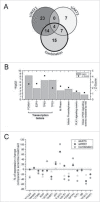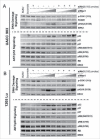Identification of WEE1 as a target to make AKT inhibition more effective in melanoma
- PMID: 28853983
- PMCID: PMC5790369
- DOI: 10.1080/15384047.2017.1360446
Identification of WEE1 as a target to make AKT inhibition more effective in melanoma
Abstract
AKT3 is one of the major therapeutic targets in melanoma but clinically targeting AKT3 alone seems to be an ineffective therapeutic approach. To identify unique strategies to enhance the efficacy of targeting AKT3, a screen was undertaken where AKT3 was co-targeted with a panel of kinases important in melanoma development. The screen identified WEE1 as the most potent target that when inhibited along with AKT3 would enhance the efficacy of targeting AKT3 in melanoma. RNAi mediated inhibition of AKT3 and WEE1 synergistically inhibited the viability of melanoma cells leading to a 65-75% decrease in tumor development. This approach was effective by mechanistically modulating pathways associated with the transcription factors p53 and FOXM1. Simultaneously regulating the activity of these two transcriptionally driven pathways, cooperatively deregulated cell cycle control and DNA damage repair to synergistically kill melanoma cells. This study uniquely identifies a potential approach to improve the efficacy of targeting AKT3 in melanoma.
Keywords: AKT3; Melanoma; WEE1; synergy.
Figures





Similar articles
-
Improving pharmacological targeting of AKT in melanoma.Cancer Lett. 2017 Sep 28;404:29-36. doi: 10.1016/j.canlet.2017.07.001. Epub 2017 Jul 11. Cancer Lett. 2017. PMID: 28705772 Free PMC article.
-
Combined inhibition of Chk1 and Wee1 as a new therapeutic strategy for mantle cell lymphoma.Oncotarget. 2015 Feb 20;6(5):3394-408. doi: 10.18632/oncotarget.2583. Oncotarget. 2015. PMID: 25428911 Free PMC article.
-
Inhibition of Wee1, AKT, and CDK4 underlies the efficacy of the HSP90 inhibitor XL888 in an in vivo model of NRAS-mutant melanoma.Mol Cancer Ther. 2013 Jun;12(6):901-12. doi: 10.1158/1535-7163.MCT-12-1003. Epub 2013 Mar 28. Mol Cancer Ther. 2013. PMID: 23538902 Free PMC article.
-
Targeting protein kinase-b3 (akt3) signaling in melanoma.Expert Opin Ther Targets. 2017 Mar;21(3):273-290. doi: 10.1080/14728222.2017.1279147. Epub 2017 Jan 16. Expert Opin Ther Targets. 2017. PMID: 28064546 Review.
-
Targeting WEE1 Kinase in Cancer.Trends Pharmacol Sci. 2016 Oct;37(10):872-881. doi: 10.1016/j.tips.2016.06.006. Epub 2016 Jul 14. Trends Pharmacol Sci. 2016. PMID: 27427153 Review.
Cited by
-
Improving pharmacological targeting of AKT in melanoma.Cancer Lett. 2017 Sep 28;404:29-36. doi: 10.1016/j.canlet.2017.07.001. Epub 2017 Jul 11. Cancer Lett. 2017. PMID: 28705772 Free PMC article.
-
Moving Synergistically Acting Drug Combinations to the Clinic by Comparing Sequential versus Simultaneous Drug Administrations.Mol Pharmacol. 2018 Mar;93(3):190-196. doi: 10.1124/mol.117.110759. Epub 2017 Dec 14. Mol Pharmacol. 2018. PMID: 29242354 Free PMC article.
-
Crosstalk among WEE1 Kinase, AKT, and GSK3 in Nav1.2 Channelosome Regulation.Int J Mol Sci. 2024 Jul 24;25(15):8069. doi: 10.3390/ijms25158069. Int J Mol Sci. 2024. PMID: 39125637 Free PMC article.
-
Targeting the PI3K pathway and DNA damage response as a therapeutic strategy in ovarian cancer.Cancer Treat Rev. 2020 Jun;86:102021. doi: 10.1016/j.ctrv.2020.102021. Epub 2020 Apr 10. Cancer Treat Rev. 2020. PMID: 32311593 Free PMC article. Review.
-
WEE1 Inhibitor Adavosertib Exerts Antitumor Effects on Colorectal Cancer, Especially in Cases with p53 Mutations.Cancers (Basel). 2024 Sep 12;16(18):3136. doi: 10.3390/cancers16183136. Cancers (Basel). 2024. PMID: 39335109 Free PMC article.
References
Publication types
MeSH terms
Substances
Grants and funding
LinkOut - more resources
Full Text Sources
Other Literature Sources
Medical
Research Materials
Miscellaneous
